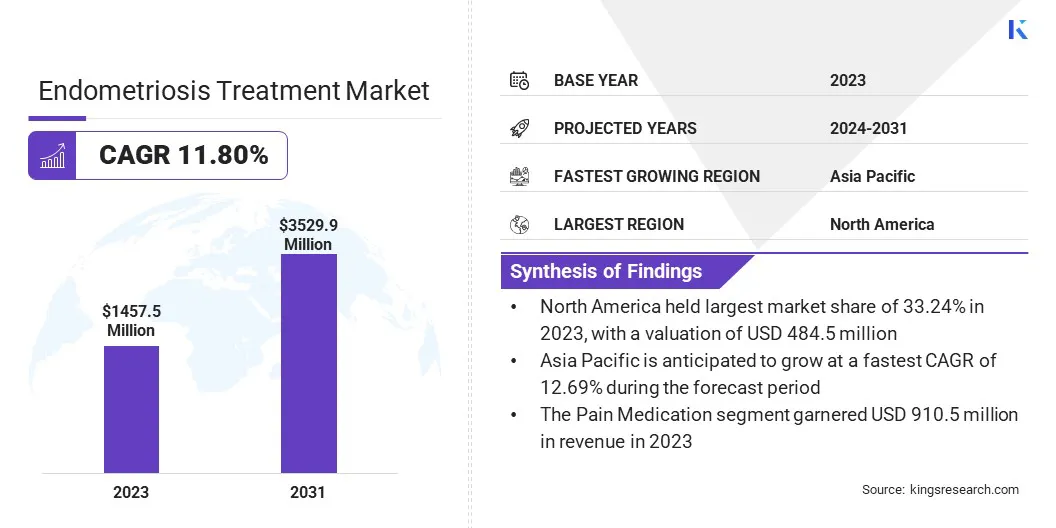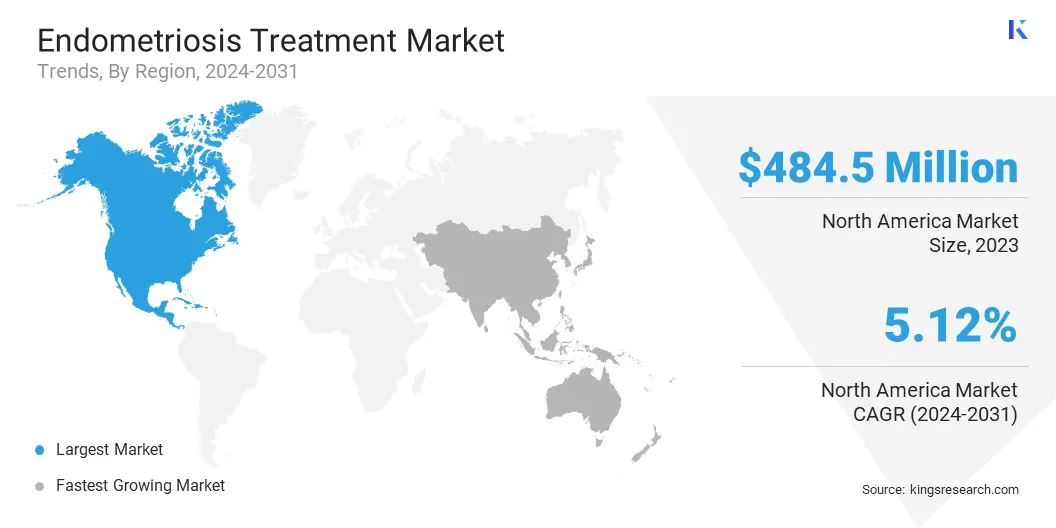Market Definition
The market focuses on the development and production of therapies for managing endometriosis. Endometriosis is a chronic condition that involves the growth of uterine-like tissue outside the uterus, causing pain, infertility, and related complications.
The report presents a comprehensive analysis of key drivers, emerging trends, and the competitive landscape shaping market dynamics through the forecast period.
Endometriosis Treatment Market Overview
Global endometriosis treatment market size was valued at USD 1457.5 million in 2023, which is estimated to be valued at USD 1617.0 million in 2024 and reach USD 3529.9 million by 2031, growing at a CAGR of 11.80% from 2024 to 2031.
Market growth is fueled by increased awareness among women and healthcare professionals, leading to early diagnosis, treatment access, and reduced time to appropriate care.
Major companies operating in the endometriosis treatment industry are Bayer AG, Pfizer Inc., AbbVie Inc., AstraZeneca, Gedeon Richter Plc., Teva Pharmaceuticals USA, Inc., Sanofi-Synthelabo Inc., Cadila Pharmaceuticals, Koye Pharmaceuticals Pvt. Ltd., Jagsonpal, Akumentis Healthcare Ltd., Kusum Healthcare, Charak Pharma Pvt Ltd, , Celsius Healthcare PVT. LTD, Torrent Pharmaceuticals Ltd., and others.
The market presents significant opportunities in fertility preservation, for affected women seeking to maintain reproductive capabilities. Advancements in fertility-preserving medications, along with rising awareness and improved reproductive technologies, are expected to drive demand for specialized solutions, supporting market growth and improving patient outcomes.
- In March 2025, UConn's Women's Health Research Symposium showcased advancements in endometriosis research, featuring the EndoRISE program, which focuses on increasing awareness, advancing fertility preservation treatments, and advocating for improved diagnostic and funding.

Key Highlights:
- The endometriosis treatment industry size was recorded at USD 1457.5 million in 2023.
- The market is projected to grow at a CAGR of 11.80% from 2024 to 2031.
- North America held a share of 33.24% in 2023, valued at USD 484.5 million.
- The pain medication segment garnered USD 910.5 million in revenue in 2023.
- The hormonal contraceptives segment is expected to reach USD 1255.0 million by 2031.
- The hospital pharmacies segment is anticipated to witness the fastest CAGR of 11.82% over the forecast period
- Asia Pacific is anticipated to grow at a CAGR of 12.69% theough the projection period.
Market Driver
Increased Awareness Among Women and Heathcare Professionals
The growing awareness among both women and healthcare professionals is propelling the progress of the market.
- According to a March 2023 article by the World Health Organization (WHO), endometriosis affects approximately 10% of women and girls of reproductive age worldwide, equating to around 190 million individuals.
Improved awareness of symptoms and risks is prompting women to seek medical help earlier, enabling timely diagnoses. Growing recognition of the condition by healthcare professionalss is improving treatment outcomes.
This increased awareness is also fostering greater patient advocacy, influencing treatment availability, shaping healthcare policies, and accelerating the development of innovative therapies with improved access to care.
- In January 2025, Celmatix Therapeutics announced the launch of a novel JNK inhibitor drug program targeting pain and inflammation associated with endometriosis, aiming to address unmet needs in first-line treatments and improve women’s health outcomes globally.
Market Challenge
Limited Effective Treatments for Pain Management
A major challenge hampering the development of the endometriosis treatment market is the limited availability of effective long-term pain management options. Despite advancements, existing treatments often fail to completely relieve pain, impacting patients' quality of life.
To address this challenge, manufacturers are focusing on developing targeted therapies addressing the underlying causes such as inflammation and hormonal imbalances. Research into novel drug classes, as well as personalized treatment plans, could offer more effective, long-term pain relief for patients.
Market Trend
Development of Non-Hormonal Medications
The development of non-hormonal medications is emerging as a key trend in the market, supported by the need for alternatives to hormone-based therapies. Many patients either cannot tolerate or choose to avoid hormone treatments due to side effects.
This has created a significant opportunity for pharmaceutical companies to innovate and develop non-hormonal options that effectively manage symptoms such as pain and inflammation without disrupting hormonal balance. As research in this area expands, it is expected to provide more personalized, patient-friendly treatment options.
- In March 2025, Michigan State University researchers advanced non-hormonal treatment options for endometriosis by uncovering key immune system interactions within lesions. This breakthrough presents promising alternatives to hormonal therapies for symptom management.
Endometriosis Treatment Market Report Snapshot
|
Segmentation
|
Details
|
|
By Type
|
Pain Medication, Hormone Therapy
|
|
By Drug Class
|
Hormonal Contraceptives, Gonadotropin-releasing Hormone, Progestin Therapy, Aromatase Inhibitors
|
|
By Distribution Channel
|
Hospital Pharmacies, Retail Pharmacies, Others,
|
|
By Region
|
North America: U.S., Canada, Mexico
|
|
Europe: France, UK, Spain, Germany, Italy, Russia, Rest of Europe
|
|
Asia-Pacific: China, Japan, India, Australia, ASEAN, South Korea, Rest of Asia-Pacific
|
|
Middle East & Africa: Turkey, UAE, Saudi Arabia, South Africa, Rest of Middle East & Africa
|
|
South America: Brazil, Argentina, Rest of South America
|
Market Segmentation
- By Type (Pain Medication and Hormone Therapy,): The pain medication segment earned USD 910.5 million in 2023, fueled by increasing demand for effective endometriosis pain management solutions.
- By Drug Class (Hormonal Contraceptives, Gonadotropin-releasing Hormone, Progestin Therapy, Aromatase Inhibitors): The hormonal contraceptives segment held a share of 35.65% in 2023, supported by their widespread use in symptom management and disease progression control.
- By Distribution Channel (Hospital Pharmacies, Retail Pharmacies, and Others): The hospital pharmacies segment is projected to reach USD 1359.0 million by 2031, largely attributed to rising diagnosis and treatment of endometriosis in clinical settings.
Endometriosis Treatment Market Regional Analysis
Based on region, the global market has been classified into North America, Europe, Asia Pacific, Middle East & Africa, and Latin America.

North America endometriosis treatment market share stood at around 33.24% in 2023, valued at USD 484.5 million. This dominance is renforced by advanced healthcare systems, increased awareness, and significant investments in medical research. The region boasts a well-established network of healthcare providers offering comprehensive diagnostic and treatment options, including cutting-edge therapies.
Additionally, a high prevalence of endometriosis, coupled with increasing patient advocacy, has led to a strong demand for effective treatments. Regulatory support and an active pharmaceutical and biotechnology industry further contribute to regional market expansion.
- In March 2025, Heranova Lifesciences launched HerResolve, a non-invasive diagnostic test for endometriosis. This innovative blood test is poised to revolutionize early diagnosis and patient comfort, particularly in North America, where the demand for advanced women’s health solutions is growing.
Asia Pacific endometriosis treatment industry is poised to grow at a robust CAGR of 12.69% over the forecast period. This rapid expansion is stimulated by rising awareness, improving healthcare infrastructure, and increasing demand for advanced diagnostic and therapeutic options.
The region’s expanding healthcare access, combined with the growing focus on women's health, has led to a surge in the adoption of innovative solutions such as non-invasive diagnostic tests and targeted treatments. These factors, along with a higher prevalence of the condition, are bolstering regional market growth.
Regulatory Frameworks
- In the U.S., the Food and Drug Administration (FDA) ensures the safety, efficacy, and security of endometriosis treatments through clinical trials, pre-market approvals, and post-market surveillance, while providing science-based health information.
- In the EU, the European Medicines Agency (EMA) ensures that endometriosis treatments are safe, effective, and of high quality, evaluating and approving them based on strict regulations, clinical trials, and drug manufacturing guidelines.
Competitive Landscape
Companies in the endometriosis treatment industry are focusing on developing innovative therapies that address the underlying causes of the disease.
Efforts are focused on developing non-hormonal, non-invasive treatments, improving diagnostic methods, and enhancing pain management. Additionally, significant investment in clinical trials supports the development of more effective, personalized solutions to enhance patient outcomes and quality of life.
- In January 2025, Gesynta Pharma successfully raised USD 30.4 million in Series B funding to further develop its innovative endometriosis treatment, vipoglanstat. The investment will facilitate Phase II clinical trials, focusing on reducing pain and lesion progression.
List of Key Companies in Endometriosis Treatment Market:
- Bayer AG
- Pfizer Inc.
- AbbVie Inc.
- AstraZeneca
- Gedeon Richter Plc.
- Teva Pharmaceuticals USA, Inc.
- Sanofi-Synthelabo Inc.
- Cadila Pharmaceuticals
- Koye Pharmaceuticals Pvt. Ltd.
- Jagsonpal
- Akumentis Healthcare Ltd.
- Kusum Healthcare
- Charak Pharma Pvt Ltd,
- Celsius Healthcare PVT. LTD
- Torrent Pharmaceuticals Ltd.
Recent Developments (Clinical Trials/Partnerships)
- In October 2024, Hope Medicine Inc. reported positive results from a global Phase 2 trial of HMI-115, a first-in-class monoclonal antibody for endometriosis, demostrating significant pain reduction and potential as a non-hormonal treatment.
- In January 2024, Scailyte partnered with Hera Biotech to develop non-surgical diagnostic tools for endometriosis. Scailyte’s AI-based platform, ScaiVision, identified relevant biomarkers , with Hera set to launch a diagnostic assay in the US fertility market.


